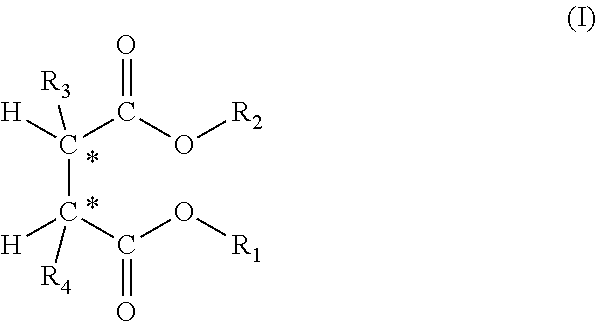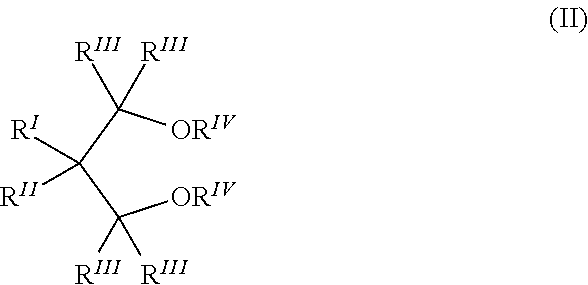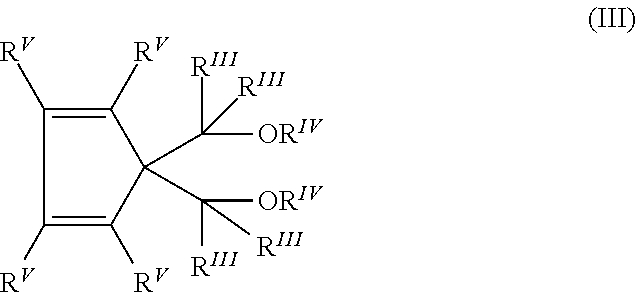Sterilizable article made of propylene copolymer
a technology of propylene copolymer and sterile article, which is applied in the direction of packaging foodstuffs, packaged goods, pharmaceutical containers, etc., can solve the problems of high base material complexity, and achieve the effect of good optical properties and good transparency
- Summary
- Abstract
- Description
- Claims
- Application Information
AI Technical Summary
Benefits of technology
Problems solved by technology
Method used
Image
Examples
example 1c (comparative)
[0146]Preparation of the Solid Catalyst Component
[0147]Into a 500 mL four-necked round flask, purged with nitrogen, 250 mL of TiCl4 were introduced at 0° C. While stirring, 10.0 g of microspheroidal MgCl2.2.1C2H5OH having average particle size of 47 μm (prepared in accordance with the method described in example 1 of EP728769) and an amount of diethyl 2,3-diisopropylsuccinate to produce a Mg / succinate molar ratio of 15 were added. The temperature was raised to 100° C. and kept at this value for 60 minutes. The stirring was then stopped and the liquid was siphoned off. After siphoning, fresh TiCl4 and an amount of 9,9-bis(methoxymethyl)fluorene such as to have a Mg / diether molar ratio of 30 were added. The temperature was raised to 110° C. and kept for 30 minutes under stirring. After sedimentation and siphoning at 85° C., fresh TiCl4 was added and the temperature was raised to 90° C. for 15 min. After sedimentation and siphoning at 90° C. the solid was washed three times with anhydr...
examples 2 and 3c (comparative)
[0162]These examples were worked according to Example 1C, except that the polymerization run was conducted in continuous mode in a gas-phase polymerization reactor comprising two interconnected polymerization zones, a riser and a downcomer, as described in European Patent EP782587, and in the granulation step 20 ppm of Luperox 101 were added.
[0163]The main precontact, prepolymerization and polymerization conditions and the quantities of monomers and hydrogen fed to the polymerization reactor are reported in Table 1. Characterization data for the obtained polymers and bottles are reported in Table 2.
[0164]
TABLE 1Process conditionsExample1C23CTEAL / external donorwt / wt5.133TEAL / catalystwt / wt2868TEAL / C3−Kg / t0.17N / AN / ATemperature° C.707070Pressurebar-g38.92525Split holdup riserwt %N / A3942Split holdup downcomerwt %N / A6158C2− risermole %N / A2.72.4C2− feedKg / h2.1N / AN / AH2 / C3− risermol / molN / A0.0070.01H2 feed concentrationppm750N / AN / ANotes:C2− = ethylene;C3− = propylene;H2 = hydrogen;N / A = not a...
PUM
| Property | Measurement | Unit |
|---|---|---|
| flexural modulus | aaaaa | aaaaa |
| haze | aaaaa | aaaaa |
| haze | aaaaa | aaaaa |
Abstract
Description
Claims
Application Information
 Login to View More
Login to View More - R&D
- Intellectual Property
- Life Sciences
- Materials
- Tech Scout
- Unparalleled Data Quality
- Higher Quality Content
- 60% Fewer Hallucinations
Browse by: Latest US Patents, China's latest patents, Technical Efficacy Thesaurus, Application Domain, Technology Topic, Popular Technical Reports.
© 2025 PatSnap. All rights reserved.Legal|Privacy policy|Modern Slavery Act Transparency Statement|Sitemap|About US| Contact US: help@patsnap.com



